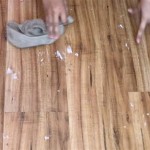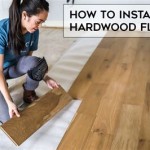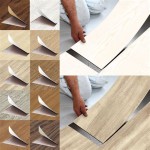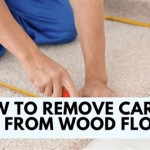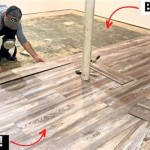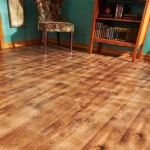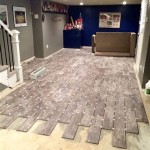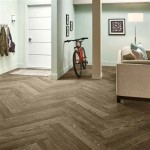How To Remove Sticky Residue From Wooden Floors
Sticky residue on wooden floors is a common household problem, often caused by spills, adhesives, tape, furniture pads, or tracked-in substances. This unsightly and often bothersome residue can detract from the beauty of the hardwood and can be difficult to remove effectively without damaging the finish. Understanding the nature of the residue and the appropriate removal techniques is crucial for restoring the floor to its original condition. This article provides a comprehensive guide to removing sticky residue from wooden floors, offering a variety of methods and precautions to ensure success.
Before embarking on any cleaning process, it is imperative to identify the type of finish on the wooden floor. Common types include polyurethane, varnish, lacquer, wax, and oil. Applying an unsuitable cleaning method or solution can harm the floor's surface and cause discoloration, dullness, or even permanent damage. To determine the finish type, a simple test can be conducted in an inconspicuous area. Apply a small amount of mineral spirits to a clean cloth and gently rub it onto the floor. If the finish becomes sticky or comes off on the cloth, it is likely a wax finish. If there is no reaction, it is probably a polyurethane, varnish, or lacquer finish. For oil finishes, the floor will generally appear to absorb the mineral spirits, leaving a darkened area that may eventually fade.
Proper preparation is also vital. This includes sweeping or vacuuming the floor to remove loose dirt, dust, and debris. This step prevents abrasive particles from scratching the floor during the cleaning process. It is also recommended to protect the surrounding areas with drop cloths or plastic sheeting, especially if using liquid solutions that could potentially splash.
Identifying the Residue and Selecting the Appropriate Cleaning Method
The effectiveness of any cleaning method is contingent on accurately identifying the type of sticky residue present on the wooden floor. Different types of residues require different approaches. For instance, adhesive residue from tape or stickers often responds well to solvents, while food spills may be easier to remove with gentler cleaning agents. Consider the following common types of sticky residues:
- Adhesive Residue: This residue is typically left behind by tape, stickers, or furniture pads. It can be particularly stubborn and may require solvents to break down the adhesive bonds.
- Food Spills: Sticky food spills, such as syrup, honey, or juice, can harden and become difficult to remove. These spills usually respond well to warm water and mild detergents.
- Gum: Chewing gum stuck to the floor can be a challenge to remove without damaging the finish. Freezing the gum can make it brittle and easier to scrape off.
- Grease and Oil: Grease and oil spills can leave a slippery and sticky residue on the floor. These substances often require degreasers to effectively remove them.
- Wax Buildup: Over time, wax finishes can accumulate layers of wax, leading to a sticky and dull appearance. Wax strippers are needed to remove this buildup.
Once the type of residue is identified, the appropriate cleaning method can be selected. It is always recommended to start with the gentlest method first and gradually escalate to more aggressive techniques if necessary. Testing any cleaning solution in an inconspicuous area is crucial to ensure that it does not damage the floor's finish.
Gentle Cleaning Methods
For many types of sticky residue, gentle cleaning methods may be sufficient to remove the substance without causing harm to the wooden floor. These methods typically involve readily available household products and simple techniques.
Warm Water and Mild Dish Soap: This is often the first line of defense for removing sticky residue. Mix a small amount of mild dish soap with warm water to create a cleaning solution. Dip a soft cloth or sponge into the solution, wring out the excess water, and gently scrub the affected area. Avoid using excessive water, as it can seep into the wood and cause damage. After scrubbing, wipe the area clean with a damp cloth and dry it thoroughly.
Vinegar and Water Solution: Vinegar is a natural cleaning agent that can effectively remove some types of sticky residue. Mix equal parts white vinegar and warm water in a spray bottle. Spray the solution onto the affected area and let it sit for a few minutes. Then, wipe the area clean with a damp cloth and dry it thoroughly. It is crucial to note that vinegar is acidic and should be used sparingly, as it can potentially damage some finishes, especially wax finishes. Test the solution in an inconspicuous area before applying it to the entire affected area.
Baking Soda Paste: Baking soda is a mild abrasive that can help to loosen sticky residue. Mix baking soda with water to create a paste. Apply the paste to the affected area and let it sit for a few minutes. Then, gently scrub the area with a soft cloth or sponge. Wipe the area clean with a damp cloth and dry it thoroughly. Baking soda can be slightly abrasive, so it should be used with caution on delicate finishes.
Steam Cleaning: A steam cleaner can effectively loosen and remove sticky residue without the use of harsh chemicals. The steam penetrates the residue, making it easier to wipe away. However, it is crucial to use a steam cleaner specifically designed for hardwood floors and to follow the manufacturer's instructions carefully. Excessive steam can damage the floor's finish. Ensure the floor is properly ventilated and dry it thoroughly after steam cleaning.
Stronger Cleaning Methods for Stubborn Residue
When gentle cleaning methods prove ineffective, stronger cleaning methods may be necessary to remove stubborn sticky residue. These methods often involve solvents or specialized cleaning products. It is imperative to exercise caution when using these methods, as they can potentially damage the floor's finish if not used properly. Always test the cleaning solution in an inconspicuous area before applying it to the entire affected area.
Mineral Spirits: Mineral spirits are a solvent that can effectively dissolve adhesive residue, grease, and other sticky substances. Apply a small amount of mineral spirits to a clean cloth and gently rub it onto the affected area. Avoid pouring mineral spirits directly onto the floor. After removing the residue, wipe the area clean with a damp cloth and dry it thoroughly. Mineral spirits are flammable and should be used in a well-ventilated area. Wear gloves to protect your skin.
Rubbing Alcohol (Isopropyl Alcohol): Rubbing alcohol is another solvent that can be used to remove sticky residue. Apply a small amount of rubbing alcohol to a clean cloth and gently rub it onto the affected area. Avoid pouring rubbing alcohol directly onto the floor. After removing the residue, wipe the area clean with a damp cloth and dry it thoroughly. Rubbing alcohol is also flammable and should be used in a well-ventilated area.
Goo Gone or Similar Adhesive Removers: These products are specifically designed to remove adhesive residue. Follow the manufacturer's instructions carefully. Typically, the product is applied to the affected area and allowed to sit for a few minutes before being wiped away. After removing the residue, wipe the area clean with a damp cloth and dry it thoroughly. Ensure that the product is compatible with the floor's finish before using it.
Acetone: Acetone is a powerful solvent that can dissolve many types of sticky residue. However, it is also highly potent and can easily damage the floor's finish. Acetone should only be used as a last resort and with extreme caution. Apply a very small amount of acetone to a clean cloth and gently dab it onto the affected area. Avoid rubbing the area, as this can spread the acetone and increase the risk of damage. After removing the residue, wipe the area clean with a damp cloth and dry it thoroughly. Acetone is highly flammable and should be used in a well-ventilated area. Wear gloves and eye protection.
Ice: For chewing gum and other sticky substances that harden when cold, applying ice can be an effective removal method. Place a bag of ice or an ice pack on top of the residue for several minutes. This will harden the residue, making it brittle and easier to scrape off with a plastic scraper or putty knife. Exercise caution when scraping the residue to avoid scratching the floor's finish.
Heat Gun or Hair Dryer: Applying heat can soften some types of sticky residue, making them easier to remove. Use a heat gun or hair dryer on a low setting and direct the heat onto the affected area. Avoid overheating the area, as this can damage the floor's finish. Gently scrape away the softened residue with a plastic scraper or putty knife. Exercise caution to avoid burning yourself or damaging the floor.
After removing the sticky residue, it is crucial to clean the area thoroughly with a damp cloth and dry it completely. This will prevent the residue from reattaching and will also help to restore the floor's finish.
In cases where the sticky residue has caused damage to the floor's finish, it may be necessary to refinish the affected area. This involves sanding down the damaged finish and applying a new coat of finish. Refinishing is a more complex process that may require the assistance of a professional.
Preventing sticky residue buildup is always preferable to having to remove it. Regular cleaning and maintenance can help to keep wooden floors in good condition and prevent sticky substances from accumulating. This includes sweeping or vacuuming the floor regularly to remove loose dirt and debris, wiping up spills immediately, and using appropriate floor cleaners. Using mats or rugs in high-traffic areas can also help to protect the floor from spills and dirt.

First Aid Remove Sticky Residue Simple Decorating Tips

How To Remove Glue From Wood Floors Pete S

Removing Glue Or Adhesive From Hardwood Floors The Speckled Goat

How To Remove Sticky Residue From Hardwood Floors

4 Ways To Remove Adhesive From A Hardwood Floor Wikihow

Removing Glue Or Adhesive From Hardwood Floors The Speckled Goat

4 Ways To Remove Adhesive From A Hardwood Floor Wikihow

4 Reasons Your Floors Are Sticky And How To Fix Them

First Aid Remove Sticky Residue Simple Decorating Tips

Removing Glue Tar Paper From Hardwood Floors Farmhouse Restoration Day In The Life
See Also
